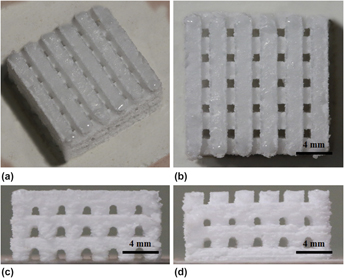Article contents
Development of bioceramic bone scaffolds by introducing triple liquid phases
Published online by Cambridge University Press: 11 October 2016
Abstract

In this study, a system of triple liquid phases was developed using Li2CO3, Na2CO3, and K2CO3 to improve the densification of the akermanite scaffolds fabricated by selective laser sintering (SLS). The system formed a ternary liquid phase (Li2CO3–Na2CO3–K2CO3) at 399 °C, a binary liquid phase (Na2CO3–K2CO3) at 695 °C, and a unitary liquid phase (K2CO3) at 891 °C during sintering process. The effects of the liquid phases on the sinterability and mechanical properties of the scaffolds were investigated. The fracture toughness and compressive strength is increased by 43 and 152% with liquid phases increasing from 0 to 4 wt%, respectively. This was explained that liquid phases enhanced densification via improving diffusion kinetics and inducing particle rearrangement. In addition, the scaffolds maintained favorable hydroxyapatite (HA) formation ability and cell proliferation ability, which was proved by simulated body fluid (SBF) test and microculture tetrazolium test (MTT), respectively.
Keywords
- Type
- Articles
- Information
- Copyright
- Copyright © Materials Research Society 2016
References
REFERENCES
- 3
- Cited by





